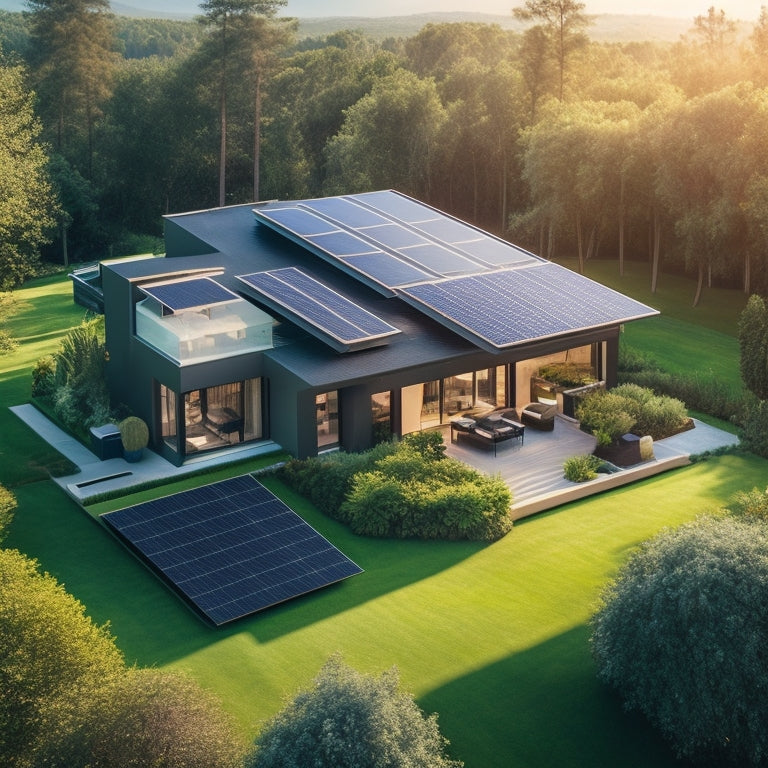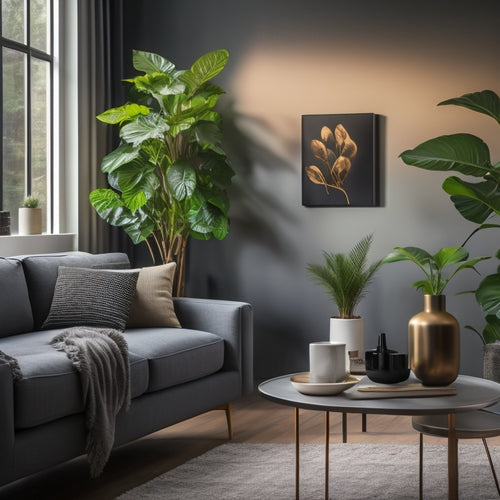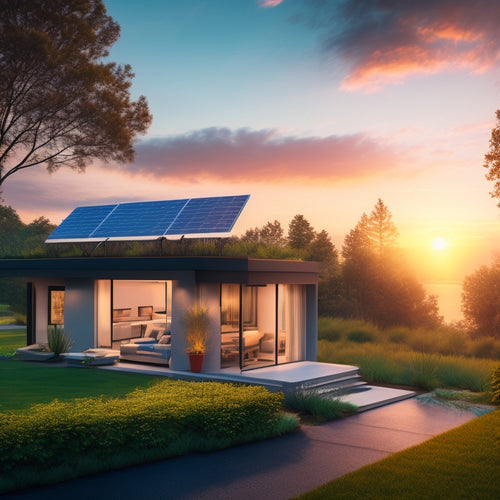
Large Homes: Complete Solar Panel Systems
Share
When designing a complete solar panel system for your large home, you'll need to take into account your unique energy requirements, factoring in occupants, daily habits, and seasonal variations to guarantee a reliable supply. You'll want to assess your energy needs through audits and calculations, then select the right solar panels, taking into account efficiency ratings, durability, and reputation. Next, you'll need to choose suitable system components, including inverters and battery storage, and plan for installation and maintenance costs. To maximize energy efficiency, incorporate smart technology and sustainable design practices. By addressing these key aspects, you'll be well on your way to utilizing the full potential of solar energy for your large home - and there's more to investigate on this path to energy independence.
Overview
- For large homes, conduct an energy needs assessment to determine the required solar panel system size and optimize energy consumption.
- Select high-efficiency solar panels (>20% rating) that suit your budget and energy requirements, considering durability and manufacturer reputation.
- Choose the right inverter type (string, micro, or power optimizer) and consider battery storage options for energy independence and grid resilience.
- Installation costs vary ($2.50-$3.50/watt) depending on roof size, orientation, and complexity, with regular maintenance essential for optimal performance.
- Ensure a well-designed and installed system with smart technology integration to maximize energy efficiency and minimize losses (25%-40% efficiency gain potential).
Assessing Energy Needs and Usage
When sizing a solar panel system for a large home, one essential step is to accurately assess your energy needs and usage.
You'll need to calculate your total energy consumption, considering lifestyle factors like the number of occupants and your daily habits. Conducting energy audits can help identify inefficiencies and peak hours and standby power consumption to guarantee a reliable and efficient energy supply.
Don't forget to account for seasonal variations in energy usage, as well as the efficiency of your appliances. Review your past utility rates to get an accurate depiction of your energy needs.
Think about future expansions or upgrades to your home that may impact your energy usage. By understanding your energy needs, you can design a solar panel system that meets your unique requirements, giving you the freedom to generate clean energy and reduce your reliance on the grid.
Choosing the Right Solar Panel
With numerous solar panels available on the market, selecting the right one for your large home can be overwhelming.
You'll need to evaluate various panel types, each with its benefits and drawbacks. Monocrystalline panels, for instance, offer high efficiency ratings but are more expensive. Polycrystalline panels, on the other hand, are more affordable but have lower efficiency ratings. Thin-film panels are another option, providing a balance between cost and efficiency.
When choosing a panel, look for high efficiency ratings, typically above 20% high-efficiency panels. This guarantees you maximize your energy output while minimizing the number of panels needed.
Additionally, assess factors like durability and lifespan, as well as manufacturer reputation, to confirm you get a quality panel that will last.
System Components and Accessories
As you move forward with your solar panel system installation, you'll need to reflect on the various components and accessories that will optimize its performance.
A critical component is the solar inverter, which converts DC power from your solar panels to AC power for your home. When selecting an inverter, it's crucial to take into account factors such as energy requirements and sizing to ascertain the inverter can handle your daily energy needs.
You'll need to choose from different solar inverter types, such as string inverters, microinverters, or power optimizers, each with their own advantages and disadvantages.
Additionally, you may want to explore battery storage options to store excess energy generated during the day for use during the night or during power outages. This can provide you with greater energy independence and freedom from the grid.
Installation and Maintenance Costs
Efficiency takes center stage when calculating the total cost of ownership for your solar panel system, and installation and maintenance costs are essential factors to take into account.
You'll want to take into account the upfront installation costs, which can range from $2.50 to $3.50 per watt, depending on the system size and complexity. Installation challenges, such as roof size and orientation, can also impact the final cost.
To minimize maintenance costs, you'll want to follow some key maintenance tips, including regular cleaning and inspection of the panels, as well as monitoring the system's performance.
Maximizing Energy Efficiency Gains
Twenty-five to forty percent of a solar panel system's energy efficiency gains can be lost due to inadequate installation, poor system design, or inefficient energy storage.
To maximize energy efficiency gains, you'll want to guarantee your system is designed with sustainability practices in mind. This includes incorporating smart technology that optimizes energy production and consumption.
Energy auditing can help identify areas of inefficiency, allowing you to make targeted improvements. Additionally, consider investing in advanced energy storage solutions that can store excess energy for later use.
Effective grid integration is also essential, enabling you to seamlessly switch between solar power and traditional energy sources.
Frequently Asked Questions
Can I Sell Excess Energy Back to the Grid?
You can sell excess energy back to the grid through net metering, earning energy credits that offset your utility bills; many energy credit programs allow you to bank these credits for future use, giving you more control over your energy expenses.
Does Solar Panel Color Affect Energy Output?
You're wondering if solar panel color affects energy output; surprisingly, it does. Darker panels absorb more heat, reducing solar panel efficiency, while lighter panels prioritize aesthetics over energy output, so you'll need to balance your aesthetic preferences with energy needs.
Will Solar Panels Increase My Property Value?
You'll likely see an increase in property value after installing solar panels, as a higher property appraisal reflects energy savings and potential return on investment, driven by market demand, buyer preferences, and local incentives, despite initial installation costs and varying neighborhood trends.
Can I Install Solar Panels on a Metal Roof?
You're worried that your metal roof might be a hurdle, but don't let that stop you - metal roofs offer advantages like added durability and easier installation, which you'll appreciate when considering solar panel installation.
Do Solar Panels Work in Shaded Areas?
You'll find that solar panels don't perform well in shaded areas, as shading effects greatly reduce energy output. Partial shading can even cause a ripple effect, decreasing overall system efficiency, so it's crucial to assess your roof's shading before installation.
Ready to Buy
You've finally made the switch to a complete solar panel system for your large home - congratulations! You've likely spent a small fortune, but ironically, it's an investment that'll save you money in the long run. With the right system, you'll be generating enough energy to power your sprawling estate, and then some. So, go ahead and crank up the AC, fire up the hot tub, and bask in the guilt-free glow of renewable energy. Your wallet - and the planet - will thank you.
Related Posts
-

Smart Home Thermostats to Revolutionize Your Space
Smart home thermostats revolutionize your space by providing precise temperature control and optimizing energy saving...
-

What Happens Without a Charge Controller in Solar Panels
Without a charge controller in your solar panel system, you risk overheating batteries due to overcharging, which can...
-

The Future of Residential Energy Storage
The future of residential energy storage looks promising and cost-effective for you. With lithium-ion battery prices ...


